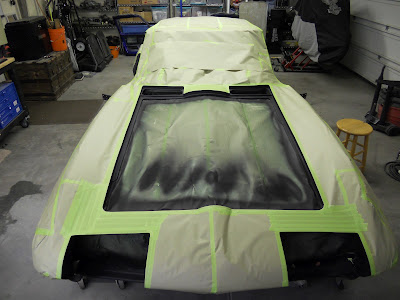I grabbed the grinder and removed the crack until it was almost gone with exception to just a very thin amount on the back side of the panel. I always try to leave a little something for the new fiberglass and resin to rest against. It acts as a form.
Before I get too carried away with the grinding, sanding and painting I thought it best to protect all the work that's been done on the inside of the doors. Masking tape and masking paper was just the ticket.
I spent several hours the last couple weeks getting the doors in the condition shown below. All the fiberglass work is done, the skins were guide coated and the low spots were filled in where necessary. The outside window openings were then masked off in preparation for paint. Take note of how little of the green primer remains after all the body work.
Last weekend I applied 2 to 3 coats of two-part epoxy primer then I set the doors aside and allowed them to dry for 1 week.
This weekend I guide coated the doors again. I find it best to use a contrasting primer for the guide coat, not a glossy paint, but a primer. The reason is because the glossy paint gums up the sandpaper where the primer will not.
Now that the second guide coat is done you can see how much more of the green primer is left on the doors. That means the doors are getting flatter. There are still areas where fiberglass is showing so the doors will need another coat of primer.
And here they are with their third coat of primer. I painted these this weekend so they will have to dry for about a week before I can guide coat them again. They really look good and I suspect one more guide coat should do it.
Look who showed up! Ty and his wife Bonnie flew into town a few days ago and Gerri and I got to spend an evening with them. Not one too miss out on working in the garage, Ty grabbed a rag and polished the blue paint. Yes it was mostly for the photo but it was still good to see Ty back in the garage.
While the doors dry I'll start doing similar work to the hood. The hood as you recall is in need of a lot of TLC. Fortunately, we have the know how and I am prepared to spend many hours making it right.
Thanks for watching.


























































